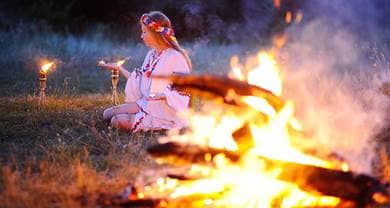- Trending:
- Pope Leo Xiv
- |
- Israel
- |
- Trump
- |
- Social Justice
- |
- Peace
- |
- Love

RELIGION LIBRARY
Paganism
Ethics and Community
Community Organization
As practiced in the English-speaking world, Paganism in the 21st century is decentralized and diverse. Unlike other religions where organization at the community level often means owning and maintaining a community building (a church, synagogue, mosque, or meditation center), nearly all Pagan groups meet in people's homes or in accessible outdoor settings (such as parks or state forests). Some groups, however, do own and manage their own nature preserves. This article examines some common organizational structures among modern North American Pagans; it does not consider how other Pagan groups (particularly among indigenous peoples, or in the past) may have structured their common spiritual lives; nor is it meant to be exhaustive even among contemporary Pagan religions.
Because Paganism involves the experience of mystical communion with, or devotion to, nature and/or Pagan deities, it is entirely possible to be a solitary practitioner of the Pagan path. As a spirituality devoid of dogma, there is no mandate to organize. Many people may engage in Pagan spirituality as a purely private and personal pursuit; some writers of nature spirituality books have thus addressed their work specifically to the solitary practitioner. Scott Cunningham's Wicca: A Guide for the Solitary Practitioner (1993) is a best-selling book, indicating the widespread appeal of Pagan spirituality to those who do not wish to affiliate with a group.
While solitary practice is acceptable, many Pagans do affiliate with others, typically in small groups that are either governed by consensus or some form of democratic process. These groups are known as circles, groves, tribes, or covens (a term used mostly by Wiccans and witches). Some groups (particularly traditionalist covens) have established leadership structures, although the small size of these groups supports direct accountability between the leaders and the membership. Despite a romantic notion that covens of witches should be limited to thirteen members (promoted by early authors like Gerald Gardner), in practice Wiccan and other Pagan groups can have anywhere from three to five or up to 100 or more members. Often larger groups will "hive" or split into smaller groups, thus enabling the religion to grow and allowing new leadership to emerge.
Some groups are part of lineages or traditions, established by students of Pagan elders who go on to form their own groups, but remain under the tutelage of their mentors. Other groups are newly formed by enterprising individuals who read books on the religion and simply start their own gathering. On the regional or national level, umbrella organizations like the Covenant of the Goddess or the Pagan Federation enable independent Pagan groups to join together for common purposes, such as networking or political advocacy.
Requirements for joining Wiccan or other Pagan groups vary. Some groups can only be joined through a ritual initiation, which typically occurs after a period of study. Other groups, such as the druid organization Ár nDraíocht Féin, are membership-based: one joins simply by submitting an application. Some groups have a dues structure; others ask for pledges; others do not require financial contributions but expect members to shoulder their share of group-related work.
Groups typically engage in educational and ritual work: elders teach younger and newer members the theology and spirituality of Pagan religion in general and of their tradition in particular; communal rituals help the group members to put their spirituality into practice. Groups also often will engage in fellowship and community-building activities, as well as service projects, often oriented toward environmental preservation.
As mentioned above, some Pagan individuals and groups own parcels of land that function as nature preserves as well as gathering places for the community at large. For many Pagans, retreating from urban settings to forest or wilderness environments, even if only for a weekend or a week, can be an important aspect of nature-oriented spiritual practice. Such Pagan nature preserves might be used only by one particular group or tradition, or might be more open to a broad cross-section of Wiccan, Pagan, nature-centered, occult, and goddess-oriented groups. Large-scale gatherings, known as Pagan festivals, can attract anywhere from fifty to a thousand or more participants. Participants generally camp on the land, offer and attend a variety of classes and workshops, engage in rituals, tend a communal bonfire, engage in communal music-making (usually involving a hand-drum circle), and purchase Pagan books, jewelry, and other merchandise. For many Pagans, attending a regional or national gathering is the highlight of the year.
Finally, it should be noted that many Pagans are active online, and that numerous groups, mail lists, bulletin boards, blogs, meet-up groups, and other online resources are devoted to the learning and practice of Paganism. The relative anonymity of the internet allows newcomers to explore Pagan spirituality without necessarily committing to it. The wealth of resources online enable interested parties to learn about different traditions within Paganism - and even study one particular tradition in-depth - all from the safety and comfort of one's computer. Although some practitioners may "graduate" from online engagement with the Pagan community to in-person involvement with a group, for many the online dimension of their religious practice remains an essential part of their spiritual life.
Back to Religion Library
Because Paganism involves the experience of mystical communion with, or devotion to, nature and/or Pagan deities, it is entirely possible to be a solitary practitioner of the Pagan path. As a spirituality devoid of dogma, there is no mandate to organize. Many people may engage in Pagan spirituality as a purely private and personal pursuit; some writers of nature spirituality books have thus addressed their work specifically to the solitary practitioner. Scott Cunningham's Wicca: A Guide for the Solitary Practitioner (1993) is a best-selling book, indicating the widespread appeal of Pagan spirituality to those who do not wish to affiliate with a group.
While solitary practice is acceptable, many Pagans do affiliate with others, typically in small groups that are either governed by consensus or some form of democratic process. These groups are known as circles, groves, tribes, or covens (a term used mostly by Wiccans and witches). Some groups (particularly traditionalist covens) have established leadership structures, although the small size of these groups supports direct accountability between the leaders and the membership. Despite a romantic notion that covens of witches should be limited to thirteen members (promoted by early authors like Gerald Gardner), in practice Wiccan and other Pagan groups can have anywhere from three to five or up to 100 or more members. Often larger groups will "hive" or split into smaller groups, thus enabling the religion to grow and allowing new leadership to emerge.
Some groups are part of lineages or traditions, established by students of Pagan elders who go on to form their own groups, but remain under the tutelage of their mentors. Other groups are newly formed by enterprising individuals who read books on the religion and simply start their own gathering. On the regional or national level, umbrella organizations like the Covenant of the Goddess or the Pagan Federation enable independent Pagan groups to join together for common purposes, such as networking or political advocacy.
Requirements for joining Wiccan or other Pagan groups vary. Some groups can only be joined through a ritual initiation, which typically occurs after a period of study. Other groups, such as the druid organization Ár nDraíocht Féin, are membership-based: one joins simply by submitting an application. Some groups have a dues structure; others ask for pledges; others do not require financial contributions but expect members to shoulder their share of group-related work.
Groups typically engage in educational and ritual work: elders teach younger and newer members the theology and spirituality of Pagan religion in general and of their tradition in particular; communal rituals help the group members to put their spirituality into practice. Groups also often will engage in fellowship and community-building activities, as well as service projects, often oriented toward environmental preservation.
As mentioned above, some Pagan individuals and groups own parcels of land that function as nature preserves as well as gathering places for the community at large. For many Pagans, retreating from urban settings to forest or wilderness environments, even if only for a weekend or a week, can be an important aspect of nature-oriented spiritual practice. Such Pagan nature preserves might be used only by one particular group or tradition, or might be more open to a broad cross-section of Wiccan, Pagan, nature-centered, occult, and goddess-oriented groups. Large-scale gatherings, known as Pagan festivals, can attract anywhere from fifty to a thousand or more participants. Participants generally camp on the land, offer and attend a variety of classes and workshops, engage in rituals, tend a communal bonfire, engage in communal music-making (usually involving a hand-drum circle), and purchase Pagan books, jewelry, and other merchandise. For many Pagans, attending a regional or national gathering is the highlight of the year.
Finally, it should be noted that many Pagans are active online, and that numerous groups, mail lists, bulletin boards, blogs, meet-up groups, and other online resources are devoted to the learning and practice of Paganism. The relative anonymity of the internet allows newcomers to explore Pagan spirituality without necessarily committing to it. The wealth of resources online enable interested parties to learn about different traditions within Paganism - and even study one particular tradition in-depth - all from the safety and comfort of one's computer. Although some practitioners may "graduate" from online engagement with the Pagan community to in-person involvement with a group, for many the online dimension of their religious practice remains an essential part of their spiritual life.
Study Questions:
1. What is the role of community within Paganism?
2. How are Pagan groups structured? How can a new member join?
3. What are Pagan festivals like?
4. How has technology fostered Pagan community?
Editor's picks See all columnists










